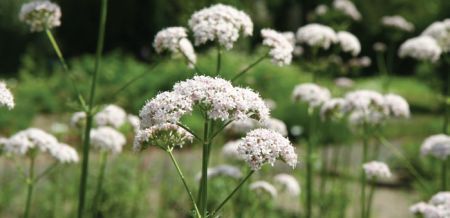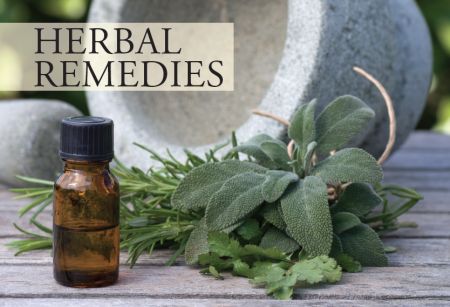
An herb is a plant or plant part used for its scent, flavor, or therapeutic properties. Herbs have been used in various forms for centuries for their health benefits. Many are now sold as tablets, capsules, powders, teas, extracts, and fresh or dried plants. However, some have side effects and may interact with other drugs you are taking.
To use an herbal product as safely as possible:
• Consult your doctor first.
• Do not take a bigger dose than the label recommends.
• Take it under the guidance of a trained medical professional.
• Be especially cautious if you are pregnant or nursing.
Herbal supplements are sold in many forms: as fresh or dried products; liquid or solid extracts; and tablets, capsules, powders, and tea bags. For example, fresh ginger root is often found in the produce section of food stores; dried ginger root is sold packaged in tea bags, capsules, or tablets; and liquid preparations made from ginger root are also sold. A particular group of chemicals or a single chemical may be isolated from a botanical and sold as a dietary supplement, usually in tablet or capsule form. Common preparations include teas, decoctions, tinctures, and extracts:
A tea, also known as an infusion, is made by adding boiling water to fresh or dried botanicals and steeping them. The tea may be drunk either hot or cold.
Some roots, bark, and berries require more forceful treatment to extract their desired ingredients. They are simmered in boiling water for longer periods than teas, making a decoction, which also may be drunk hot or cold.
A tincture is made by soaking a botanical in a solution of alcohol and water. Tinctures are sold as liquids and are used for concentrating and preserving a botanical. They are made in different strengths that are expressed as botanical-to-extract ratios (i.e., ratios of the weight of the dried botanical to the volume or weight of the finished product).
An extract is made by soaking the botanical in a liquid that removes specific types of chemicals. The liquid can be used as is or evaporated to make a dry extract for use in capsules or tablets.
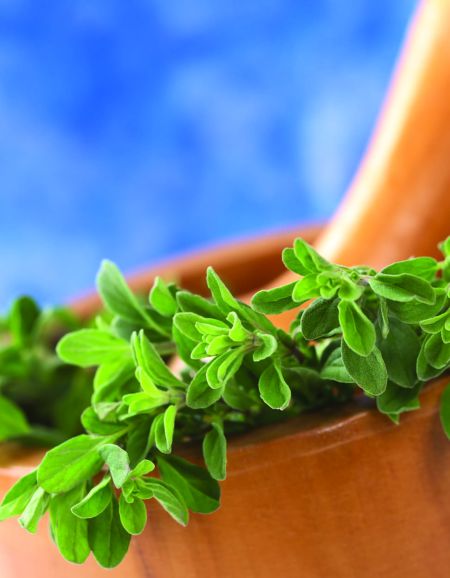
Make Your Own Herbal Tincture
Tinctures help to concentrate and preserve the health benefits of your herbs. To use, mix 1 teaspoon of tincture with juice, tea, or water and drink no more than three times a day.
1. Pick the fresh herbs, removing any dirty, wilted, or damaged parts. Do not wash. Be sure you know whether it is the stems, leaves, roots, or flowers that have the health benefits, and use only those parts.
2. Coarsely chop the plant parts. Flowers can be left whole.
3. Clean and dry a small glass jar with an airtight lid and put the herbs inside. Fill the jar with 100-proof vodka or warm cider vinegar until plant parts are fully immersed. Screw the lid on securely and label the jar.
4. Store for 6 to 8 weeks, gently shaking a few times a week.
5. Strain out the herbs and store the liquid tincture in a clean, dry bottle. Be sure to label the jar with the ingredients and date and store it in a safe place away from children’s reach.
Herbs for Your Ailments
Here is a list of common herbs that can be used to cure or alleviate the symptoms of conditions ranging from cancer to acne to the common cold. If you are taking any other medications or supplements, check with your doctor before trying any herbs. As with any medication, every body is unique and certain herbs can have adverse side effects for certain people, so pay attention to your body and cease taking any herbs that make you feel worse in any way. It’s a good idea to try one herb at a time per condition and to keep a journal documenting what you take when and how you feel. This way you’ll be able to tell more easily what effects the herbs are having.
Aloe Vera
Uses: The clear gel in aloe is used topically to treat osteoarthritis, burns, and sunburn. The green part can be made into a juice or dried and taken orally to treat a variety of conditions, such as diabetes, asthma, epilepsy, and osteoarthritis.
Aloe vera can be used topically to treat and soothe a variety of skin irritations.
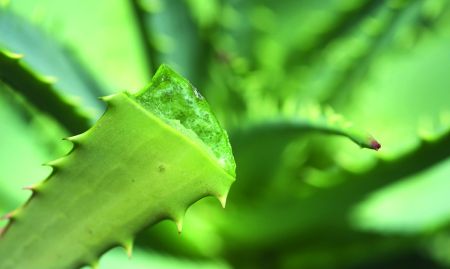
Cautions: Using aloe vera on surgical wounds may inhibit their healing. If taken orally, aloe vera can produce abdominal cramps and diarrhea, which can decrease the absorption of many drugs.
If you have diabetes and take glucose-lowering medication, you should be careful of taking aloe orally, as studies suggest that aloe may decrease blood glucose levels.
Astragalus
Uses: Astragalus was traditionally used in Chinese medicine in combination with other herbs to help boost the immune system. It is still used widely in China for chronic hepatitis and as an additional cancer therapy. Astragalus is commonly used to boost the immune system to help colds and upper respiratory infections, and has also been used to fight heart disease. The astragalus plant root is used in soups, teas, extracts, and capsules and is generally used with other herbs, like ginseng, angelica, and licorice.
Cautions: Astragalus may interact with medications that suppress the immune system (such as those taken by cancer patients or organ transplant recipients).
Bilberry
Uses: Bilberry fruit is used to treat diarrhea, menstrual cramps, eye problems, varicose veins, and circulatory problems. The leaf of a bilberry is used to treat diabetes. It’s claimed that bilberry fruit also helps improve night vision, but this is not clinically proven. The bilberry fruit can be eaten or made into an extract. Likewise, its leaves can be used in tea or made into an extract.
Cautions: Though bilberry fruit is considered safe, high doses of the leaf or leaf extract may have possible toxic side effects.
Chamomile
Uses: Chamomile has a calming effect and is often used to counteract sleeplessness and anxiety, as well as diarrhea and gastrointestinal conditions. Topically, chamomile is used in the treatment of skin conditions and for mouth ulcers (particularly due to cancer treatment). The chamomile plant has flowering tops, which are used to make tea, extracts, capsules, and tablets. It can also be applied as a skin cream or ointment or even be used as a mouth rinse.
Bilberries are a close relative of blueberries and can be eaten whole or made into an extract.
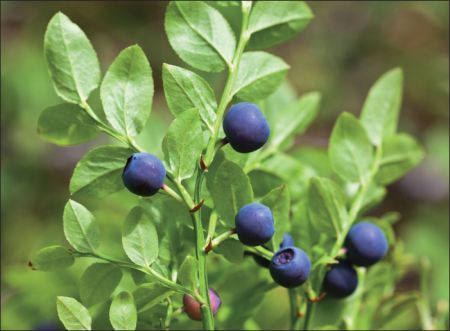
Chamomile flowers can be used to make a relaxing tea.

Cautions: Some people have developed rare allergic reactions from eating or coming into contact with chamomile. These reactions include skin rashes, swelling of the throat, shortness of breath, and anaphylaxis. People allergic to related plants, such as daisies, ragweed, or marigolds, should be careful when coming into contact with chamomile.
Cranberry
Uses: Cranberry fruit and leaves are used in healing many conditions, including wounds, urinary disorders, diarrhea, diabetes, and stomach and liver problems. Cranberries are often utilized in treating urinary tract infections and stomach ulcers. They may also be useful in preventing dental plaque and in preventing E. coli bacteria from adhering to cells along the urinary tract wall. Cranberry fruit can be eaten straight, made into juice, or used in the form of extracts, tea, or tablets and taken as a dietary supplement.
Cautions: Drinking copious amounts of cranberry juice can cause an upset stomach and diarrhea.
Dandelion
Uses: Dandelions, throughout history, have been most commonly used to treat liver and kidney diseases and spleen problems. Dandelions are sometimes used in liver and kidney tonics, as a diuretic, and for simple digestive issues. The dandelion’s leaves and roots (and sometimes the entire plant) are used in teas, capsules, and extracts. The leaves are used in salads or are cooked, and the flowers are used to make wine.
Cautions: While using dandelions is typically safe, there are a few instances of upset stomach and diarrhea caused by the plant, as well as allergic reactions. If your gallbladder is inflamed or infected, you should avoid using dandelion products.
Echinacea
Uses: Traditionally, echinacea has been used to boost the immune system to help prevent colds, flu, and various infections. Echinacea can also be used for wounds, acne, and boils. The roots and exposed plant are used, either fresh or dried, for teas, juice, extracts, or in preparations for external use.
Cautions: Echinacea, taken orally, generally does not cause any problems. Some people do have allergic reactions (rashes, increased asthma, anaphylaxis), but typically only gastrointestinal problems were experienced. If you are allergic to any plants in the daisy family, it may be best to steer clear of echinacea.
Evening Primrose Oil
Uses: Since the 1930s, evening primrose oil has been used to fight eczema and recently, it has been used for other inflammatory conditions. Evening primrose oil is also used in the treatment of breast pain during the menstrual cycle, symptoms of menopause, and premenstrual issues. It may also relieve pain associated with rheumatoid arthritis.
The oil is extracted from the evening primrose seeds. You’ll find it in capsule form at many health food stores.
Cautions: There may be some mild side effects, such as gastrointestinal upset or headache.
Flaxseed and Flaxseed Oil
Uses: Flaxseed is typically used as a laxative and to alleviate hot flashes. Flaxseed oil is used for treating arthritis pain. Both herbs are used to fight high cholesterol and can be beneficial for those with heart disease. Flaxseed, in either its whole or crushed form, may be mixed with water or juice and ingested. It is also available as a powder. Flaxseed oil can be taken in either a liquid or capsule form.
Cautions: It is essential to take flaxseed with lots of water, or constipation could worsen. Further, flaxseed fiber may decrease the body’s ability to absorb other oral medications and so should not be taken together.
Garlic
Garlic grows best in soil that is pH 6.5 to 7.0.
Uses: Garlic is typically used as a dietary supplement for those with high cholesterol, heart disease, and high blood pressure. It may help decrease the hardening of the arteries and is also used in the prevention of stomach and colon cancer. It is also used topically or orally to heal some infections, including ear infections. Garlic cloves may be eaten either raw or cooked or they may be dried or powdered and used in capsules. Oil and other extracts can be obtained from garlic cloves.

Echinacea is beautiful as well as useful medicinally. It grows well in moderately dry soil.
Cautions: Some common side effects of garlic are breath and body odor, heartburn, upset stomach, and allergic reactions. Garlic can also thin blood and so should not be used before surgeries or dental work, especially if you have a bleeding disorder. It also has an adverse effect on drugs used to fight HIV.
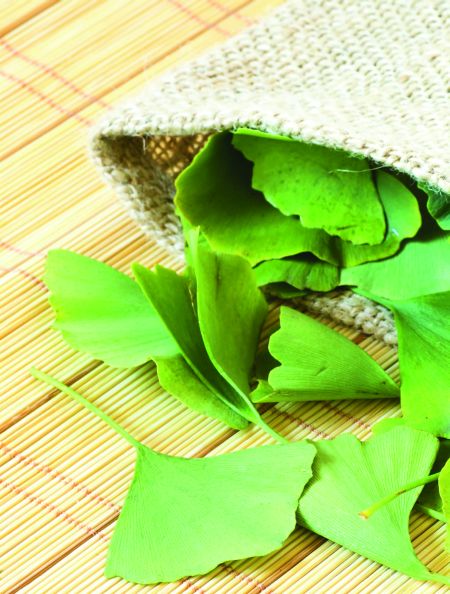
Ginkgo leaves
Ginger
Uses: Ginger is commonly used in asian medicines to treat stomachaches, nausea, and diarrhea. Many U.S. dietary supplements containing ginger are used to help fight cold and flu and can be used to relieve post-surgery nausea or nausea related to pregnancy. It has also been used for arthritis and other joint and muscle pain. Ginger root can be found fresh or dried, in tablets, capsules, extracts, and teas.
Cautions: Side effects are rare but can include gas, bloating, heartburn, and, for some people, nausea.
Ginkgo
Uses: Traditionally, extract from ginkgo leaves has been used in the treatment of illnesses such as asthma, bronchitis, fatigue, and tinnitus. People use gingko leaf extract in the hopes that it will help improve their memory (especially in the treatment of Alzheimer’s disease and dementia). It is also taken to treat sexual dysfunction, multiple sclerosis, and other health issues. Ginkgo leaf extracts are made into tablets, capsules, or teas. Sometimes the extracts can also be found in skin care products.
Cautions: Some common side effects are headache, nausea, gastrointestinal upset, diarrhea, dizziness, or skin irritations. Ginkgo may also increase bleeding risks, so those having surgery or with bleeding disorders should consult a doctor before using any ginkgo products. Uncooked ginkgo seeds are toxic and can cause seizures.
Ginseng (Asian)
Uses: Ginseng is used to help boost the immune system and contribute to the overall health of an individual. It has been used traditionally and currently for improving those who are recovering from illnesses, increasing stamina and mental and physical performance, treating erectile dysfunction and symptoms of menopause, and lowering blood glucose levels and blood pressure. In some studies, ginseng has been proven to lower blood glucose levels and boost immune systems. The ginseng root is dried and made into tablets, capsules, extracts, and teas. It can also be made into creams for external use.
Cautions: Limiting ginseng intake to three months at a time will most likely reduce any potential side effects. The most common side effects are headaches and sleep issues, along with some allergic reactions. If you have diabetes and are taking blood-sugar lowering medications, it is advisable not to use ginseng, as it too lowers blood sugar.
Grape Seed Extract
Uses: Grape seed extract is used for treating heart and blood vessel conditions, such as high blood pressure, high cholesterol, and low circulation. It is also used for those struggling with complications from diabetes, such as nerve and eye damage. Grape seed extract is also used in treating vision problems, reducing swelling after surgery, and cancer prevention. Extracted from grape seeds, it is readily available in tablets and capsules.
Cautions: Common side effects of prolonged grape seed oil use are headaches; dry, itchy scalp; dizziness; and nausea.
Green Tea
Uses: Green tea and its extracts have been used in preventing and treating breast, stomach, and skin cancers, as well as improving mental alertness, aiding weight loss, lowering cholesterol, and preventing the sun from damaging the skin. Green tea is typically brewed and drunk. Extracts can be taken in capsule form and sometimes green tea can be found in skin care products.
Cautions: While green tea is generally safe for most adults, there have been a few reports of liver problems occurring in those who take green tea extracts. Thus, these extracts should always be taken with food and should not be taken at all by those with liver disorders. Green tea also contains caffeine and can cause insomnia, anxiety, irritability, nausea, diarrhea, or frequent urination.
Lavender
Uses: Lavender, in the past, has been used as an antiseptic and to help with mental health issues. Now it is more commonly taken for anxiety, restlessness, insomnia, and depression, and can also be used to fight headaches, upset stomach, and hair loss.
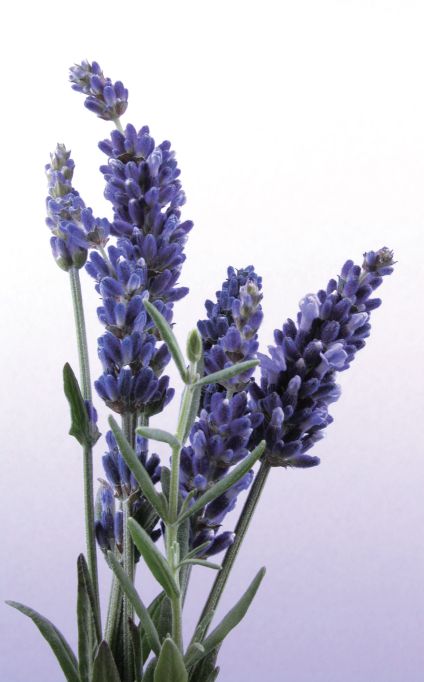
Lavender has a soothing, relaxing aroma. It can also be ingested in the form of tea or extracts, or even in baked goods.
Most commonly used in aromatherapy, lavender essential oil can also be diluted with other oils and rubbed on the skin. When dried, lavender flowers can be made into teas or liquid extracts and ingested.
Cautions: Lavender oil applied to the skin may cause some irritation and is poisonous if ingested. Lavender tea may cause headache, appetite change, and constipation. If used with sedatives, it may increase drowsiness.
Licorice Root
Uses: Traditionally, licorice root is used as a dietary supplement for the treatment of stomach ulcers, bronchitis, and sore throat. It is also used to help cure infections caused by viruses. When licorice root is peeled, it can be dried and made into powder. It is available in capsules, tablets, and extracts.
Cautions: If taken in large doses, licorice root can cause high blood pressure, water retention, and low potassium levels, leading to heart conditions. Taken with diuretics, it could cause the body’s potassium levels to fall to dangerously low levels. If you have heart disease or high blood pressure, you should practice caution when taking licorice root. Large doses of licorice root may cause preterm labor in pregnant women.
Milk Thistle
Uses: Milk thistle is used as a protective measure for liver problems and in the treatment of liver cirrhosis, chronic hepatitis, and gallbladder diseases. It is also used to lower cholesterol, reduce insulin resistance in those with type 2 diabetes, and reduce the growth of cancerous cells in the breast, cervix, or prostate. Milk thistle seeds are used to make capsules, extracts, and strong teas.
Cautions: Occasionally, milk thistle may cause diarrhea, upset stomach, or bloating. It may also cause allergic reactions, especially in those with allergies to the daisy family.
Mistletoe
Uses: For hundreds of years, mistletoe has been used to treat seizures and headaches. In Europe, mistletoe is used to treat cancer and to boost the immune system. The shoots and berries of mistletoe are used in oral extracts. In Europe, these extracts are prescription drugs, available only by injection.
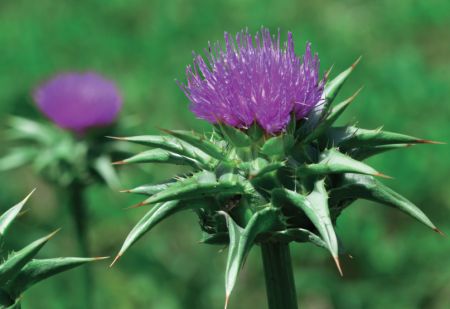
Milk thistle grows in a wide range of soil types and will thrive in sunny or partly shady areas.
Cautions: Eating raw and unprocessed mistletoe may cause vomiting, seizures, a slowing of the heart rate, and even death. American mistletoe cannot be used for medical purposes. Injected mistletoe extract can irritate the skin and produce low-grade fevers or flu-like symptoms. There is also a slight risk for severe allergic reactions that could cause difficulty breathing.
Peppermint Oil
Uses: Usually, peppermint oil is used to treat nausea, indigestion, and cold symptoms and it can also be used to allay headaches, muscle and nerve pain, and irritable bowel syndrome. Peppermint essential oil can be taken orally in small doses. It can also be diluted with other oils and applied to the skin.
Cautions: Common side effects include allergic reactions and heartburn, though peppermint oil is relatively safe in small doses.
Red Clover
Uses: Red clover has been used for treating cancer, whooping cough, asthma, and indigestion. It is also used to allay menopausal symptoms, breast pain, high cholesterol, osteoporosis, and enlarged prostate. The red clover flower is used in preparing extracts in tablets and capsules as well as teas.
Cautions: No serious side effects have been reported, though it is unclear if it is safe for use by pregnant women, women who are breastfeeding, or women with breast or other hormonal cancer. The estrogen in red clover may also increase a woman’s chance of contracting cancer in the uterus.
Soy
Uses: Soy products are typically used for treating high cholesterol, menopausal symptoms, osteoporosis, problems with memory, breast and prostate cancer, and high blood pressure. Available in dietary supplements, soy can be found in tablet or capsule form. Soybeans may be cooked and eaten, or made into tofu, soy milk, and other foods

Cautions: Using soy supplements or eating soy products can create minor stomach and bowel problems, and in rare cases, allergic reactions causing breathing difficulties and rashes. While there is no conclusive evidence linking soy with increased risk of breast cancer, women who have or are at risk of getting breast cancer should consult a doctor about using soy products.
St. John’s Wort
Uses: St. John’s wort has been used for hundreds of years to treat mental illness and nerve pain. It has also been used as a sedative, in malaria treatment, and as a balm for wounds, burns, and insect bites. It is commonly used to treat depression, anxiety, and sleep disorders. The flowers are used, in extract form, for tea and capsules.
Cautions: A possible side effect of using St. John’s wort is increased light sensitivity. other common side effects are anxiety, dry mouth, dizziness, gastrointestinal symptoms, fatigue, headache, and sexual dysfunction. St. John’s wort also interacts with drugs and may interfere with the way in which our body breaks down those drugs. It may affect antidepressants, birth control pills, cyclosporine, digoxin, indinavir and other HIV drugs, irinotecan and other cancer drugs, and anticoagulants.
If you are taking antidepressants, be careful if also taking St. John’s wort, as it may increase the likelihood of nausea, anxiety, headache, and confusion.
Turmeric
Uses: Traditionally used in Chinese medicine, turmeric was supposed to aid digestion and liver function and to relieve arthritis pain. It was also taken to regulate the menstrual cycle. Applied directly to the skin, it was used to treat eczema and wounds. Now, turmeric is used in the treatment of heartburn, stomach ulcers, and gallstones. Turmeric is also used to reduce inflammation and in the prevention and treatment of certain cancers.
The underground stems of the turmeric plant are dried and taken orally in capsules, teas, or liquid extracts. It can also be made into a paste to be used on the skin.
Cautions: Considered safe for most adults, long-term use of turmeric may cause indigestion. Those with gallbladder problems should avoid turmeric, however, as it may worsen the condition.
Valerian
Uses: For many years, valerian has been used for sleep disorders and to treat anxiety. Further, valerian has been used to alleviate headaches, depression, irregular heartbeat, and trembling. The roots and underground stems of the valerian plant are usually made into supplements in capsule, tablet, or liquid extract form. It can also sometime be made into teas.
Cautions: Valerian is typically safe to use for short periods of time (no more than six weeks) but there is no proof about its long-term effectiveness. Some common side effects of valerian use are headaches, dizziness, upset stomach, and grogginess the morning after use.
